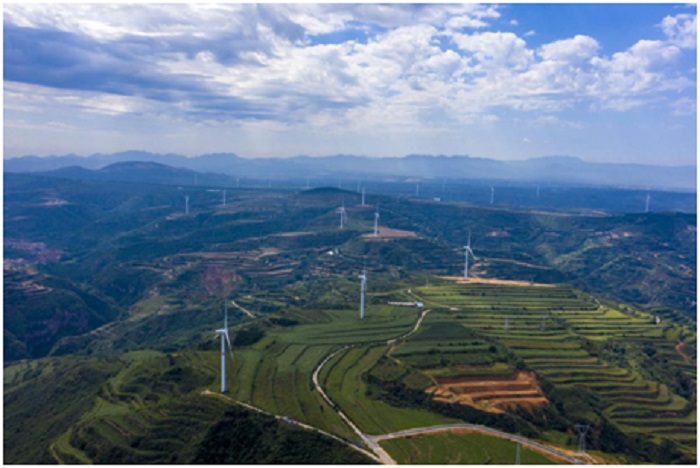



China’s energy structure was constantly optimized during the 13th Five-Year Plan period (2016-2020). The coal consumption was largely curbed; stable petroleum and gas supply was guaranteed; and clean energy occupied a larger share.
In 2019, the share of non-fossil fuels in China’s primary energy consumption stood at 15.3 percent, reaching the goal set in the 13th Five-Year Plan a year in advance.
Two years ago, coal’s share in China’s total energy consumption fell below 60 percent for the first time in history. In the same year, the country also beat its target of ultra-low emission and energy conservation and transformation outlined in its 13th Five-Year Plan two years in advance.
Besides, the country’s annual output of shale gas exceeded 10 billion cubic meters for 4 consecutive years between 2017 and 2020, and the installed capacities of both wind power and photovoltaic generation hit 200 million kW in 2019.
Optimized structure, diversified energy supply
The State Grid Qinghai Electronic Power Company supplied Sanjiangyuan region, or the sources of the Yangtze River, Yellow River, and Lancang (Mekong) River with clean energy for 100 consecutive days from May 9 to Aug. 16 the last year, setting a new world record for full-clean energy power supply. It reduced the burning of 61,000 tonnes of coals and cut 166,000 tonnes of carbon dioxide emission.
The installed renewable capacity of China kept expanding at an average rate of 12 percent each year since 2016, and the country also ranked first in the installed capacities of hydropower, wind power and photovoltaic power. By 2019, coal-generating capacity accounted for 51.95 percent of China’s total installed capacity, down by 7.05 percentage points from 2015. The country’s coal-dominated power supply system is becoming more diversified, and renewable energy is making the majority of the country’s newly added capacity of power generation.
The development of clean energy advanced from resource-intensive areas to major power consumption areas during the 13th Five-Year Plan period. As of the end of last September, central and east China, as well as the southern part of the country accounted for 31.2 percent of China’s total wind power installed capacity, 1.7 percentage points higher from a year ago. Distributed photovoltaic power generation took 32 percent of China’s total installed photovoltaic capacity, up 1.2 percentage points from a year ago.
Technological innovation lifts energy utilization
Guohua Sanhe Power Plant under China Energy is located in Langfang, north China’s Hebei province. It is free from black smoke and pungent smells. “By renovating the plant with advanced energy conservation technologies, the emissions of dust, sulfur dioxide and nitric oxide have been reduced by 90.4 percent, 50 percent and 90.9 percent respectively,” said Xu Xianlong, deputy chief engineer of the power plant.
Since the 13th Five-Year Plan period, the utilization of coals has been turning cleaner under the assistance of advanced energy conservation and environmental protection technologies. The total capacity of ultra-low-emission coal power generating units reached 890 million kW, accounting for 86 percent of the total installed capacity of all coal power generating units. China has built the world’s largest clean coal power supply system.
From 2016 to 2019, the electricity generated from renewable energy increased 10 percent on average each year, and its share in China’s total power generation capacity was lifted to 27.9 percent from 25.7 percent. The price of electricity generated from wind and solar power is basically equal to that of coal power generation.
Clean energy being widely promoted
The trading volume of China’s new energy vehicles (NEVs) ranked first in the world for 5 consecutive years. A total of 4.8 million NEVs were sold, accounting for over half of the world’s total. As of the end of last October, China was home to nearly 1.5 million charging poles, and the number of public charging poles topped the world.
Since 2017, shale gas, electricity, and other renewable energies gradually replaced coal in winter heating in rural areas of northern China. The heating in 71 percent of major rural areas is powered by clean energy.
China aims to have CO2 emissions peak before 2030 and achieve carbon neutrality before 2060. In the 14th Five-Year Plan period (2021-2025), clean energy will be further exploited in China to make the country more beautiful.


The Executive and members of the.


The Acting Director, FCT Directorate of.


President Bola Ahmed Tinubu has been.



Barely a month after resignation of.


An Abuja based Legal Practitioner, Osuagwu.



Convener of Equitable Remedy, Mrs. Magaret.


Contractors handling the contract for city.


Nigerian government may have concluded plans.


The Diplomatic Correspondents Association of Nigeria.


A rights group, “Follow Me Talk.
Leave a Comment